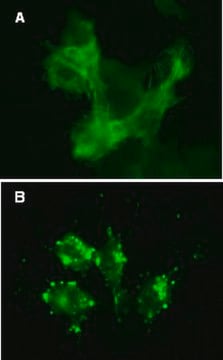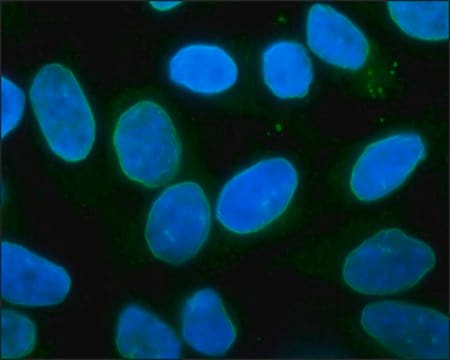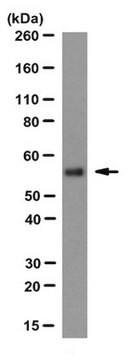06-1002
Anti-LAP2 Antibody
from rabbit, purified by affinity chromatography
Synonym(s):
LEM domain containing 4, TP alpha, TP beta/gamma, TPRP isoform alpha, TPRP isoforms beta/gamma, Thymopoietin isoform alpha, Thymopoietin, isoforms beta/gamma, Thymopoietin-related peptide isoform alpha, Thymopoietin-related peptide isoforms beta/gamma, l
About This Item
Recommended Products
biological source
rabbit
Quality Level
antibody form
affinity isolated antibody
antibody product type
primary antibodies
clone
polyclonal
purified by
affinity chromatography
species reactivity
rat, human, mouse, canine
technique(s)
immunocytochemistry: suitable
immunofluorescence: suitable
western blot: suitable
NCBI accession no.
UniProt accession no.
shipped in
wet ice
target post-translational modification
unmodified
Gene Information
human ... TMPO(7112)
General description
The best characterized isoforms of lamin binding protein LAP2 are LAP2α and LAP2β. LAP2β is a type II membrane protein in the inner nuclear membrane that binds lamin B and is important to cell viability and controlling nuclear lamina growth. LAP2α has been characterized as a nucleoplasmic protein that interacts with A-type lamins to control gene expression, transcription, and chromatin organization.
Specificity
Immunogen
Application
Representative lot data. This antibody was used to detect the nuclear lamina by immunofluorescence.
Immunocytochemistry:
Representative lot data.
A previous lot was used in confocal fluorescent analysis of A431, HeLa and NIH/3T3 cells using anti-LAP2 rabbit polyclonal antibody (Red).
Actin filaments have been labeled with AlexaFluor 488 -Phalloidin (Green). Nuclear is stained with DAPI (Blue). Positive nuclear staining.
Epigenetics & Nuclear Function
Cytoskeletal Signaling
Quality
Western Blot Analysis:
A 1:1000-1:3000 dilution of this antibody was used to detect LAP2 in HeLa cell lysate.
Target description
Physical form
Storage and Stability
Analysis Note
HeLa cell lysate
Disclaimer
Not finding the right product?
Try our Product Selector Tool.
Storage Class
12 - Non Combustible Liquids
wgk_germany
WGK 1
flash_point_f
Not applicable
flash_point_c
Not applicable
Certificates of Analysis (COA)
Search for Certificates of Analysis (COA) by entering the products Lot/Batch Number. Lot and Batch Numbers can be found on a product’s label following the words ‘Lot’ or ‘Batch’.
Already Own This Product?
Find documentation for the products that you have recently purchased in the Document Library.
Our team of scientists has experience in all areas of research including Life Science, Material Science, Chemical Synthesis, Chromatography, Analytical and many others.
Contact Technical Service








